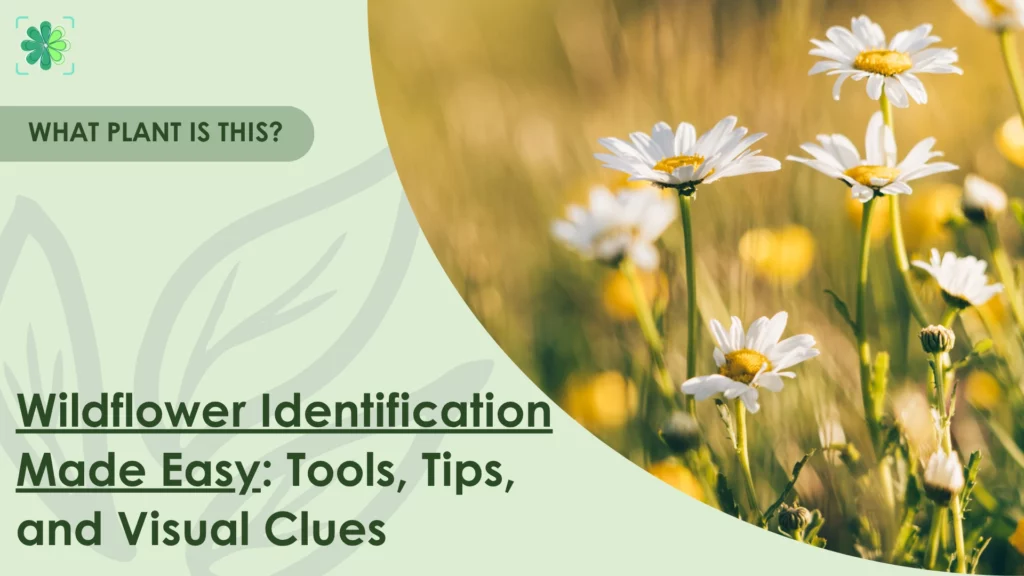
Wildflower identification connects you to the natural world in a fresh, hands-on way. With just a little attention to color, petal shape, and surrounding habitat, you can start making sense of the flowers around you. This guide shows you how to identify wildflowers using your observations, along with a few reliable tools, such as apps, PDFs, and online databases. It’s perfect for hikers, gardeners, or anyone who loves to learn from the land.
What to Observe Before You Identify a Wildflower?
Accurate wildflower identification begins with slowing down and paying attention to the plant’s details. Don’t rely on just color or one photo. Botanists recommend noting a complete set of features to avoid misidentifying common lookalikes. Here’s exactly what to observe:
1. Petal Shape and Count
Carefully count the petals, as many wildflowers follow a consistent pattern, like four, five, or multiples of three petals. Look at the shape: are they rounded, heart-shaped, lance-like, or deeply lobed? Some petals may even be fringed or form a fused tube, a common feature in families such as morning glories or honeysuckles. These characteristics often help narrow down the plant family.
2. Flower Color (Beyond Just Petals)
Color is usually the first thing people notice, but it’s essential to go beyond surface impressions. Take note of both the petals and the flower’s center, such as the disc or stamens, as they might be different in color.
Also, pay attention to whether the flower shows any color fading, spotting, or age-related changes. Some wildflowers may have patterns, such as stripes, speckles, or colored edges, instead of being a single solid hue. These subtle details can help you distinguish between similar-looking species.
3. Leaf Shape and Arrangement
Leaves are one of the most reliable ID traits, especially when flowers aren’t in bloom.
- Shape: round, oval, lance-shaped, deeply lobed, or needle-like?
- Edge: smooth (entire), toothed (serrated), or wavy?
- Arrangement: opposite (paired on stem), alternate (zigzag), or whorled (circle around stem)?
- Texture: hairy, smooth, waxy, or fuzzy?
4. Stem Texture and Height
Check the surface. Is it hairy, woody, smooth, or has a grooved texture? Consider the stem’s thickness and firmness: some are thin and floppy, others thick and upright. Observe whether the stem is branched or unbranched, and note the height of the plant. Some species creep along the ground, while others stretch up several feet.
5. Habitat Clues
Knowing the setting helps eliminate species that don’t grow in certain conditions.
- Woodland: shaded, moist, often with ferns or moss nearby.
- Meadow: sunny, grassy, with tall flowering plants and pollinators.
- Roadside: disturbed soil, compacted ground, invasive or pioneer species.
- Wetland: soggy, standing water nearby, often with cattails or reeds.
Top Tools and Guides for Wildflower Recognition
Apps That Identify Wildflowers Instantly
Mobile apps have changed how people explore plants in nature. Just snap a photo, and within seconds, you’ll get suggested species. But how well do they really work?
Google Lens is often the first tool people try. It’s fast, built into many Android phones, and can identify a wide range of plants just by pointing your camera. However, it has some apparent drawbacks:
- It lacks botanical focus and can mix up native wildflowers with cultivated garden varieties.
- There’s no real filtering by region or habitat, which can lead to false positives.
- It doesn’t provide in-depth species info or track your sightings over time.
That’s where dedicated plant apps come in.
Planteyes, for example, is a specialized app for wildflower identification that focuses specifically on native and wild-growing species. It allows you to take or upload multiple photos of the flower, leaves, and stem, and utilizes visual recognition to suggest matches. You can ask and chat with a chatbot, just like you would with an expert, in-app. The app will answer you in seconds, making sure to solve your problems as quickly as possible.
Interactive Websites and Online Databases
One of the most respected sources is the Lady Bird Johnson Wildflower Center Native Plant Database. With over 25,000 species, it allows you to filter by bloom time, plant family, soil type, sunlight requirements, and more. You can even limit your search to a specific state or climate zone, which is incredibly useful for narrowing down your options.
In the UK, Plantlife offers similar tools tailored to British flora. You can explore plants by region or season and access downloadable charts to aid identification.
Want to support biodiversity while learning? The Xerces Society also maintains regional wildflower lists that focus on pollinator-friendly species. These are especially valuable if you’re trying to identify wildflowers that support bees, butterflies, and other beneficial insects.

Wildflower database from Sleeping Bear Dunes, Michigan
Downloadable Guides and PDFs
Field guides in PDF format are ideal for offline use, particularly in remote hiking areas or locations with poor reception. They’re also great for printing and bringing along on nature walks. Some excellent sources include:
- Lady Bird Johnson Wildflower Center – offers regional PDFs organized by plant type or habitat.
- Plantlife (UK) – creates beginner-friendly wildflower charts with images and bloom timelines.
- Local botanical societies and native plant groups – often publish their downloadable guides specific to your region or ecosystem.
If you’re just starting, look for visual-heavy guides with side-by-side image comparisons. For more advanced ID, try keys that guide you through traits step-by-step, such as leaf arrangement or flower symmetry.
Field Techniques for Identifying Wildflowers
Learning how to observe plants in their natural setting is a skill that grows with practice and respect. The goal is to gather as much detail as possible without disturbing the plant or its habitat. That means no picking, uprooting, or trampling. This is how to study a wildflower up close while keeping it safe and intact:
1. Observe without picking
Instead of removing the plant, study it in its natural habitat. Look from multiple angles and take detailed notes or photos. Try crouching at ground level for a better view of the flower structure and surrounding foliage. If you’re in a group, avoid stepping on nearby plants while examining one of them.
2. Use a hand lens or magnifying loupe
A 10x hand lens is a botanist’s best friend. It lets you examine:
- Tiny hairs on stems and leaves (which may be diagnostic)
- Flower parts like stamens, pistils, and petal veins
- Surface textures such as waxy coatings, fuzz, or glands
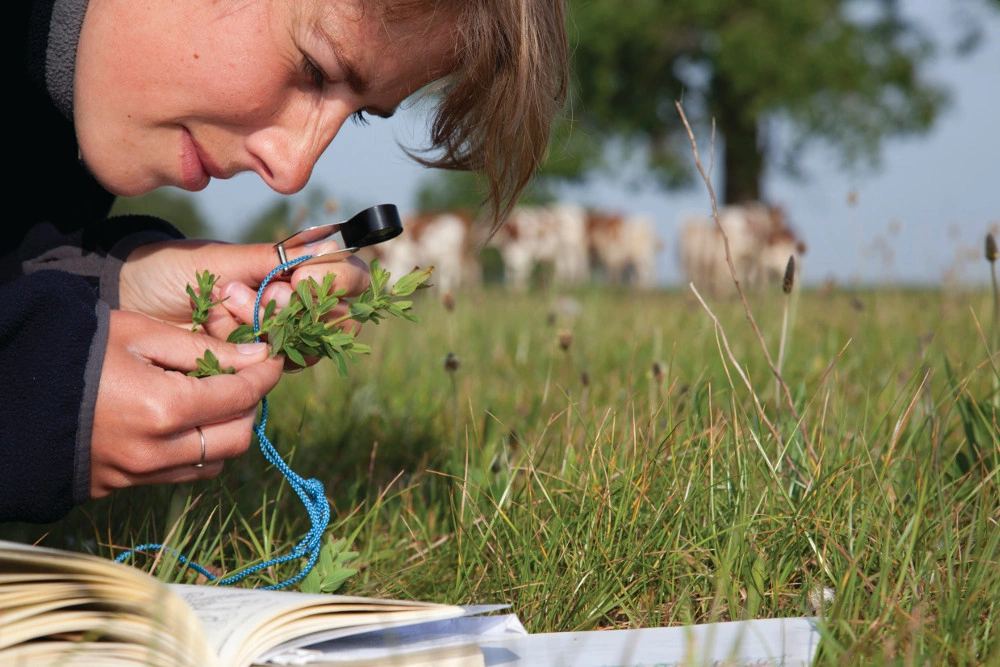
3. Check under the leaves
Many important clues are hidden below. Turn a leaf over gently to look at:
- Color differences (some plants have silvery or fuzzy undersides)
- Vein patterns (parallel, branching, or netted)
- Presence of tiny hairs, dots, or glands
4. Look for seeds, pods, or fruits
Even if the plant isn’t in full bloom, seeds and fruiting bodies can offer strong ID clues. Note shape, size, texture, and how they’re arranged. A puffball-like seed cluster points to milkweed, while a dry pod might suggest something in the pea family.
5. Understand basic botanical terms
To make sense of what you’re seeing, or when using guides and apps. It helps to know a few key terms:
- Composite flower: What looks like one flower is actually many. Dandelions and asters fall into this group.
- Simple flower: A single flower on a single stem (e.g., tulip or trillium).
- Opposite vs. alternate leaves: Opposite leaves grow in pairs across from each other, while alternate leaves stagger along the stem.
- Lobed vs. entire leaves: Lobed leaves have rounded or pointed divisions; entire leaves have smooth edges.
These field techniques sharpen your attention and build a deeper connection with your surroundings. Over time, they’ll make your wildflower identification more accurate, even in challenging conditions or off-season sightings.
Wildflower Identification by Color
Color is often the first thing we notice about a flower. While it’s not enough on its own to confirm species, grouping wildflowers by color can help you narrow your options, mainly when used alongside petal shape, leaf traits, and habitat clues. Let’s break it down by color:
1. White Wildflowers
White is a standard color among spring and summer bloomers, especially in woodlands and meadows. But it can also be one of the trickiest for accurate wildflower identification, because many white species look deceptively similar at a glance. Take Queen Anne’s Lace and Cow Parsnip, for example. Both have flat-topped white flower clusters and fern-like leaves, but here’s how to tell them apart:
- Queen Anne’s Lace (Daucus carota) is smaller, with finely divided leaves and a single dark purple floret often at the center of the umbel. The stems are hairy.
- Cow Parsnip (Heracleum maximum) is much larger—up to 8 feet tall—with broad, deeply lobed leaves and smooth, grooved stems. Its umbels are more dome-shaped than flat.

For clearer white wildflowers identification, observe:
- Flower shape: flat clusters (umbels), daisy-like centers, or star-shaped?
- Scent: some white wildflowers, like elderflower, are fragrant, while others aren’t.
- Leaf structure: finely cut, broad and toothed, or simple and rounded?
2. Yellow Wildflowers
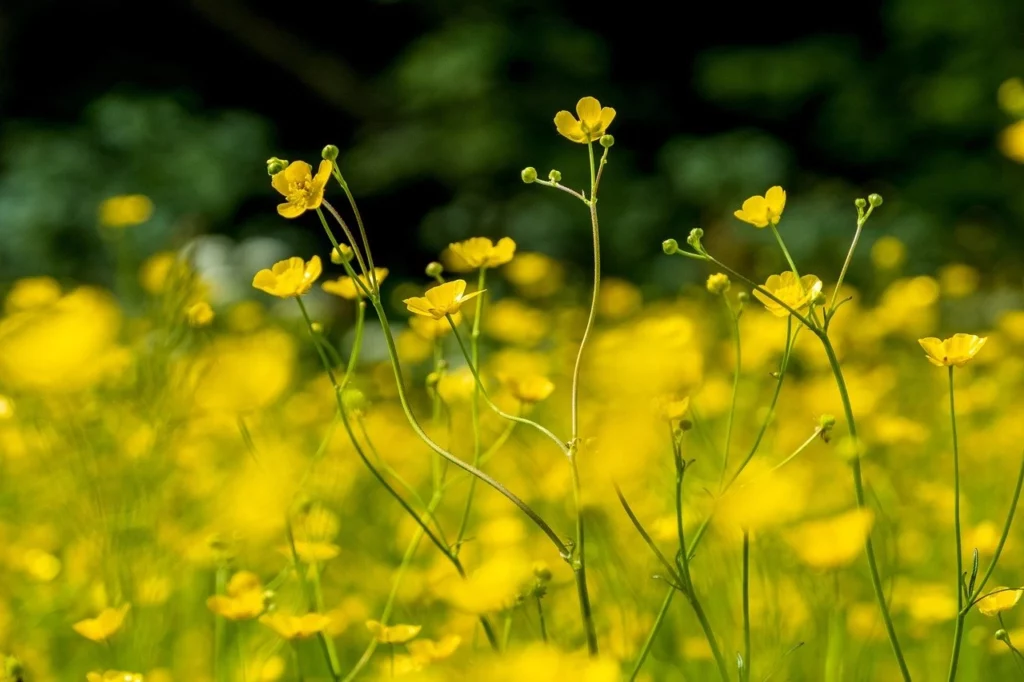
Yellow is bright, eye-catching, and abundant in open fields. You’ll often see:
- Buttercup (Ranunculus spp.): shiny petals, deeply lobed leaves.
- Coreopsis: daisy-like with toothed yellow petals and long stems.
- Goldenrod (Solidago spp.): tall, feathery plumes of clustered yellow blooms.
Pay attention to how the flower is arranged: single blossoms vs. dense sprays.
3. Purple and Blue Wildflowers
These shades overlap, especially in camera photos. Look for:
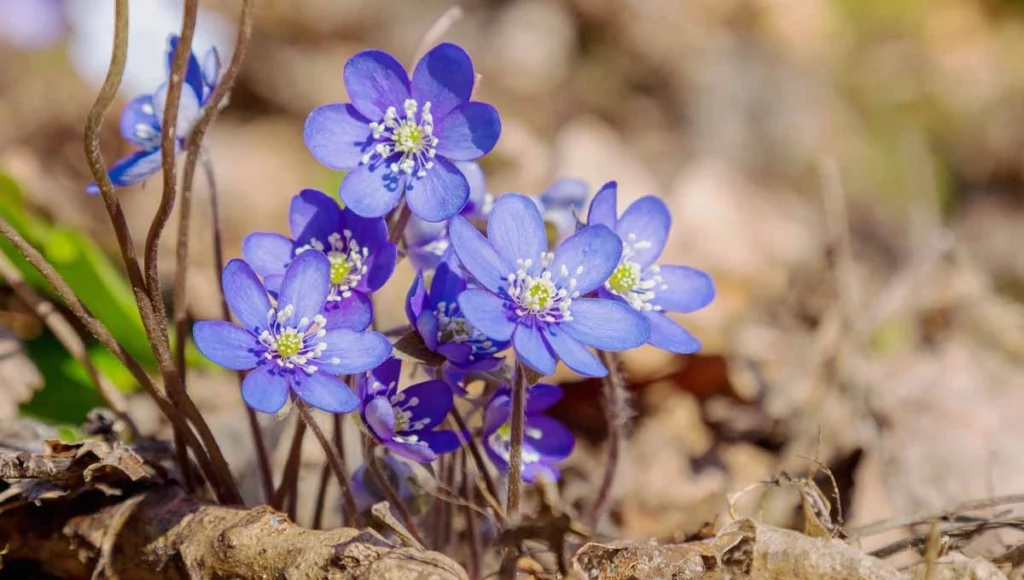
- Blue Vervain: tall spikes with tiny purplish-blue flowers.
- Harebell: delicate, bell-shaped blue blooms.
- Blue Violet: heart-shaped leaves and five-petaled flowers with a spur.
Also note the habitat. Violets favor moist woods, while vervain thrives in drier fields.
4. Pink Wildflowers
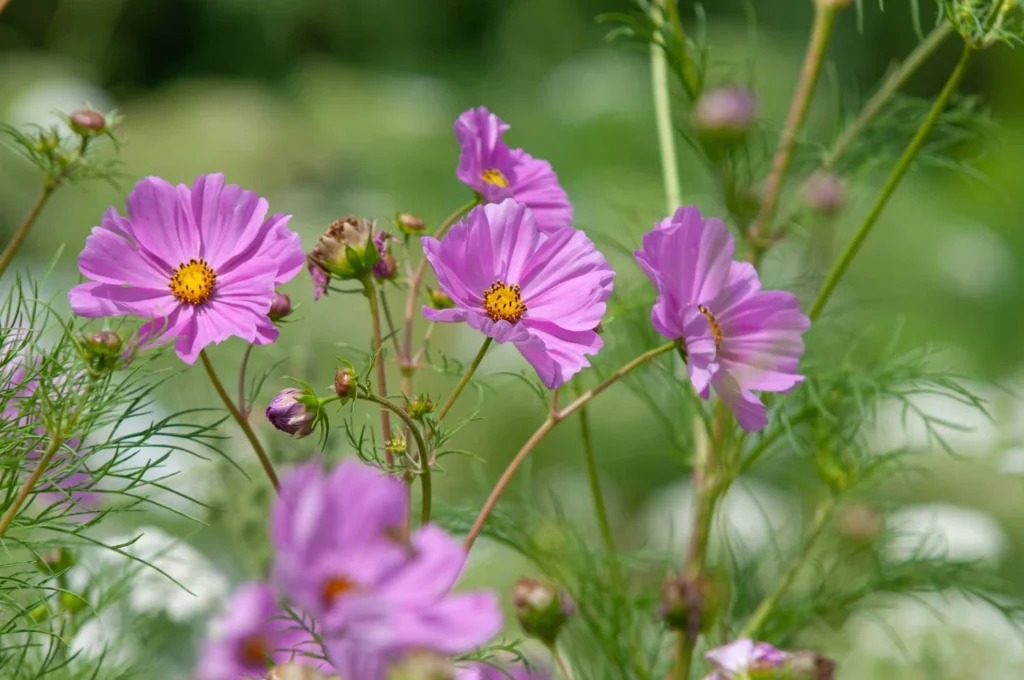
Pink flowers are common in both dune and meadow environments.
- Everlasting Pea: climbing, with pea-like blooms and tendrils.
- Spring Beauty: small woodland bloomer with striped pink petals.
- Milkweed: clusters of dusky pink flowers, often covered in butterflies.
Pink tones range from soft blush to magenta, so pay attention to petal shape and plant height for accurate ID.
Identifying Wildflower Seeds and Seedlings
While mature flowers are showy and distinctive, seeds and young plants require sharper observation and familiarity with subtle traits.
1. Wildflower Seeds: Texture, Shape, and Dispersal
When trying to identify wildflower seeds, focus on 3 key characteristics:
- Texture: Some seeds are smooth and hard (like sunflower or coreopsis), while others are coated in silky hairs (like milkweed) or have rough, bumpy surfaces (like some asters).
- Shape and Size: Seeds can be round, oval, flat, needle-like, or shaped like a tiny comma. Tiny seeds like poppy are grain-like, while others, such as lupine, resemble miniature beans.
- Dispersal Mechanism:
- Wind: Seeds like milkweed or dandelion are light, with fluff or parachute-like hairs that help them float.
- Pods: Plants like poppy produce dried capsules that rattle and release seeds through tiny openings.
- Animals or Gravity: Some seeds have hooks, burrs, or sticky coatings to cling to fur or feathers, while others drop straight to the ground.
Example:
- Milkweed seeds: flat, brown, with long silky fibers to catch the wind.
- Poppy seeds: round, blue-black, tiny like grains of sand, stored in dried pods that scatter when shaken.
These differences are often visible even without a microscope and give strong clues about species and habitat preferences.
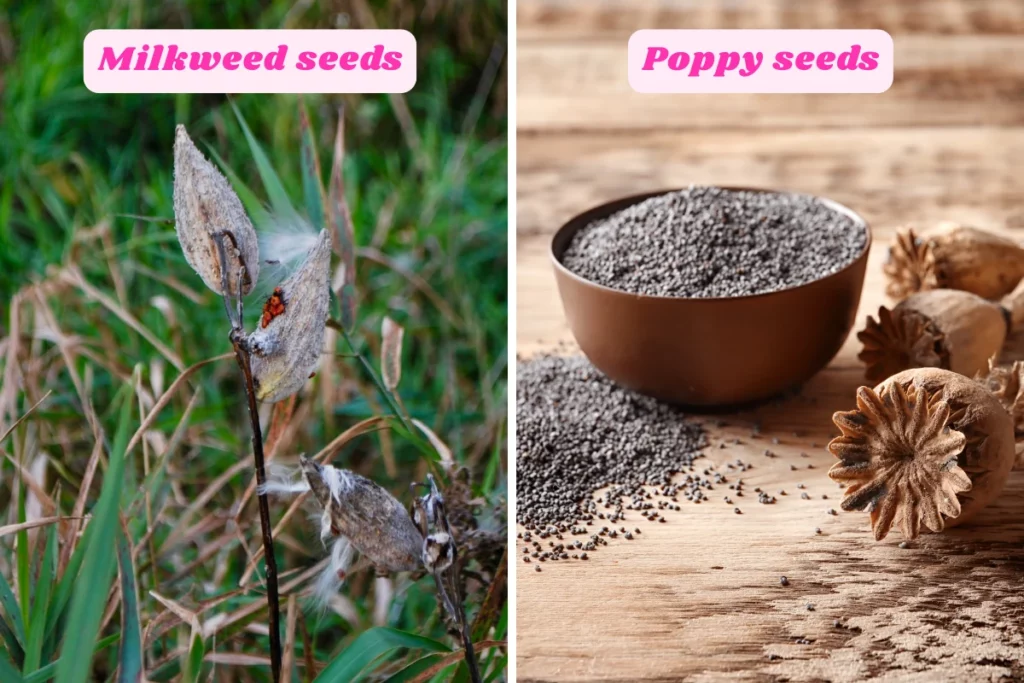
2. Identifying Wildflower Seedlings
Seedlings can look dramatically different from the adult plant. That’s why it’s important not to weed out something valuable by mistake.
- Leaf Shape: The first leaves, called cotyledons, are often round or oblong and not representative of the final leaf shape. True leaves appear shortly after and are more helpful for ID.
- Leaf Arrangement: Note whether leaves grow opposite each other, alternate, or in a rosette.
- Stem Fuzziness and Color: Some wildflower seedlings have distinct features like fuzzy stems, reddish coloration, or fine hairs on leaves that can help you separate them from common weeds.
- Growth Pattern: Observe the plant’s height and spread. Does it grow upright, sprawl along the ground, or form a small mound?
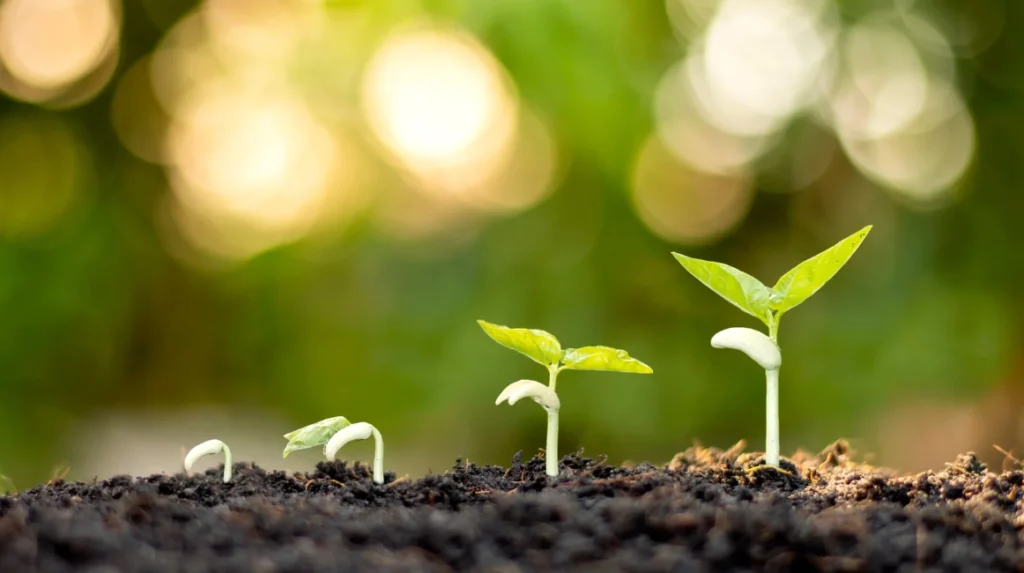
Pro tip for gardeners: Label your seed rows clearly and photograph progress every few days. Comparing these photos to a trusted wildflower seedling guide will help you track development and avoid confusion with invasive plants or aggressive weeds.
Regional and Seasonal Differences in Identifying Wildflowers
When it comes to wildflower identification, two things matter more than most: where you are and when you’re looking. The same field might be filled with violets in April, blazing with black-eyed Susans by July, and dotted with asters in September. And that’s just one location. Shift regions, and the entire cast of flowers changes.
1. Why Location Comes First?
Wildflowers are deeply tied to geography. Soil type, elevation, moisture, and climate determine what grows where. For example:
- In the American Southwest, you’ll find desert marigold and evening primrose thriving in dry, open areas.
- In the Pacific Northwest, species like camas, trillium, and bleeding heart prefer moist forest floors.
- Across the UK, lowland meadows might bloom with oxeye daisy and knapweed, while Scottish moors light up with heather.
Due to this, region-specific tools are crucial. As introduced earlier, the Lady Bird Johnson Wildflower Center database (US) and Plantlife’s guides (UK) allow you to filter species by geographic range. These resources help rule out plants that simply don’t grow in your location, saving time and increasing accuracy.
2. Then Comes Seasonality
Once you’ve narrowed down the plants that could grow in your area, the next step is to consider timing. Wildflowers bloom in seasonal waves, each bringing its palette:
- Spring brings woodland ephemerals like bloodroot, bluebells, and trout lily—plants that rush to bloom before trees leaf out.
- Summer is the peak wildflower season in meadows and open fields, with species such as milkweed, bee balm, and coreopsis attracting a wide range of pollinators.
- Fall closes the cycle with goldenrod, asters, and late-blooming gentians, often seen along roadsides or field edges.
Even within the same region, your plant ID will vary dramatically depending on the month. That’s why many apps and guides now include bloom-time filters. You’ll often see wildflower identification listings labeled with “April–June” or “Late Summer,” which helps cross-check your observations.
Conclusion
In general, wildflower identification doesn’t have to be complicated. With a bit of curiosity and the right tools, you can start recognizing local blooms in any season. If you want help in the field, try the Planteyes app. It’s free, easy to use, and built for nature lovers like you.
FAQs
What’s the best free app for wildflower identification?
Planteyes is one of the best free apps for wildflower identification, especially if you’re focused on native plants. It uses multi-angle photo analysis and region-specific data to deliver accurate results.
Can I identify wildflowers by just a photo?
Yes, but with limits. A clear, close-up photo of the flower can often get you close to the right species, especially if you also capture leaves and the overall plant structure. For more accuracy, include multiple angles and note the habitat (e.g. woodland, wetland, roadside).
How do I tell the difference between native and invasive wildflowers?
Native wildflowers tend to grow in balanced ecosystems, while invasives often spread aggressively and dominate disturbed areas. To tell the difference, check the species in a regional database like Planteyes, the Lady Bird Johnson Wildflower Center (US), or Plantlife (UK).
Are wildflower seedlings easy to recognize?
Not always. Seedlings often look very different from mature plants, especially before the first “true leaves” form. To recognize them accurately, focus on leaf shape, stem texture, and growth pattern, and use a seedling ID guide if you’re growing wildflowers from seed.


